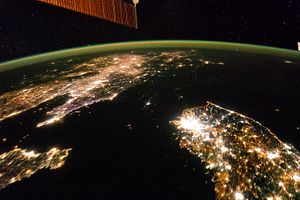Discussions of South Korea’s strategic interests often begin with an acknowledgement that the southern half of the Korean Peninsula functions as an island. Seoul has been prevented from developing land-linkages across continental Asia, with the heavily militarized inter-Korean land border effectively acting as an impermeable seal for large parts of the South’s postwar history. Identifying as a geostrategic island has led successive South Korean administrations to invest in the protection of its seaborne trade and burgeoning sea lines of communication. However, a fresh challenge to this identity emerged in late 2018 in the form of the inter-Korean road and railway reconnection project.
Plans to develop sections of North Korea’s road and rail networks, and to reconnect them to those in the South, have become a key component of recent cooperation between Seoul and Pyongyang. At the Panmunjom summit in April 2018, South Korean President Moon Jae-in and North Korean leader Kim Jong Un agreed to “adopt practical steps towards the connection and modernization of the railways and roads on the eastern transportation corridor as well as between Seoul and Sinuiju for their utilization.” Surveys of the relevant sections of the North’s underdeveloped roads and railways experienced delays for several months as a result of concerns over potential sanctions violations. However, the Moon administration eventually succeeded in pushing through the surveys, after negotiating a sanctions waiver in late November.
An official launch ceremony for the project was held on December 26, with senior officials and experts from Seoul and Pyongyang converging at Panmun Station, in the North Korean border town of Kaesong, to formally mark the beginning of the scheme. In 2019, South Korea plans to move ahead with additional surveys, and draw up designs for implementing the project.
It is important to note that these developments have taken place against a backdrop of reduced tensions along the inter-Korean border. In the final months of 2018, large parts of the Comprehensive Military Agreement (CMA), itself an outcome of Moon’s visit to Pyongyang in September, were put into force. This meant the removal of a small number of guard posts and landmines from along the Demilitarized Zone, in addition to a number of other measures that could begin to alter perceptions in South Korea about the solidity and hostility of its northern border.
At one level, the road and railway reconnection project is an explicitly inter-Korean affair, through which Seoul aims to maintain positive momentum in negotiations with Pyongyang. Yet, at the same time, there are broader implications for how South Korea views its role in the Northeast Asian region. In August 2018, Moon outlined his vision for an East Asian Railway Community, consisting of North and South Korea, China, Russia, Mongolia, Japan, and the United States. As noncontinental powers, however, the role of Japan and the United States in this proposal is unclear. In addition to the roughly 200 South and North Korean attendees taking part in the December 26 ceremony at Panmun Station were officials from China, Russia, and Mongolia — no officials from Japan or the United States were present.
Of course, the long-term viability and sustainability of the road and railway reconnection scheme, much less the broader vision of an East Asian Railway Community, is far from certain. Previous inter-Korean agreements on railway cooperation in 2000 and 2007 fell apart by 2008, amid sharply deteriorating relations between Seoul and Pyongyang. More significantly, in return for U.S. support for a sanctions waiver on the initial stages of the scheme, the Moon administration has confirmed that “Actual construction will be pursued in accordance with progress in the North’s denuclearization and the state of sanctions against the North.” As a result, the immediate future of the project is dependent on the outcome of risk-laden talks between the United States and North Korea, as well as discussions within the U.S.-South Korea alliance.
But if this road and railway reconnection scheme does manage to emerge unscathed from the inevitable twists and turns in peninsula diplomacy, South Korean strategists will likely be presented with an expanding range of opportunities for developing new land-based linkages with continental Northeast Asia, supplementing its existing maritime trade. One example of this came in 2017, when Moon expressed a willingness to join in on China’s Belt and Road Initiative (BRI).
Ultimately, were the inter-Korean road and rail reconnection or other cross-border projects to become a permanent feature, this could lead to a fundamental reshaping of South Korea’s own self-perception, with the southern half of the Korean Peninsula ceasing to think or act as a geostrategic island. In practical terms, this could mean a rebalance of resources away from the South’s recent blue-water navy efforts, toward safeguarding its newly established land trade routes with its continental neighbors.
As the Moon administration moves ahead with designs for the road and rail reconnection project, it should consider the wider implications of its current policy, which could easily entail as many pitfalls as it does opportunities. Fears have already been expressed that, by ceasing to act as an geostrategic island, Seoul might allow itself to become drawn further into Beijing’s orbit, or provide North Korea with a veto over South Korea’s energy imports. However, such views exaggerate the role that would likely be played by new, land-based trade. Ceasing to be a geostrategic island would not mean that South Korea becomes a land-locked continental state akin to Mongolia. A balanced approach based on an a return to Korea’s historic identity as a peninsula is a far more likely outcome.
Alexander M. Hynd works as a security analyst in Seoul, South Korea. He holds a BA from SOAS, University of London, and an MA from Korea University.

































